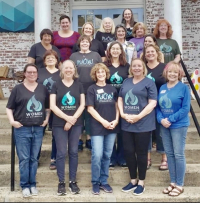Then & Now: Project catalogs the ongoing artistic value of what was once mere necessity
By Sarah Kucharski • Staff Writer
The Craft Revival: Shaping Western North Carolina Past and Present Web site is located at http://craftrevival.wcu.edu.
Much of what is considered to be historic Appalachian art work began as anything but. The quilts and clay bowls, hand-wrought iron and homemade dresses were items made for their function.
However, others saw beauty in their work and in the late 19th and early 20th century Western North Carolina crafters were encouraged to put their traditional skills to use making these same type items for sale. The money raised through craft sales allowed families to increase their standard of living and in turn shaped the mountains’ economy and culture.
This Craft Revival remains in effect — evidenced by the ever-increasing demand for locally made works, both artistic and functional in their use. Today’s artisans draw from the history of their mediums, be it clay or cotton.
Related Items
While many images and artifacts from the past still exist, written records are few. A project led by Western Carolina University aims to piece together the Craft Revival’s history using a host of documents, letters, photographs, oral histories, and objects from 1895 to 1945.
“This was an important period for our region of the Southern Appalachians,” said Anna Fariello, leader of the state-funded project. “Without the craft revival, much of the work of the mountain crafts people would have been lost and their handcrafting skills might have died out. That means there would have been only a very limited foundation for today’s continuing craft activities.”
For years such records have been scattered throughout the region in archival repositories of craft schools, museums, and local historical societies and largely inaccessible to the public. The Craft Revival project is changing that.
“We here at the Campbell Folk School as well as the other partners in this hold a significant number of things in our collection that are very important to Appalachian culture and Appalachian art craft folklore, and all the stuff was just sitting here,” said David Brose, archivist at John C. Campbell Folk School and a project heritage partner.
In the project’s first year, Brose scanned in Folk School photographs, newsletters and other documents, making images and text available for dissemination on the Craft Revival Web site.
“I like the letters that Mrs. Campbell wrote to other people and the letters they wrote back to her,” Brose said, of Folk School founder Olive Dame Campbell.
One such exchange occurred with photographer Doris Ulmann who in the 1930s took the portraits of several local people. Ulmann is perhaps the best-known photographer to capture Appalachia on film.
“Ulmann saw dignity and intrinsic beauty in the people here,” Brose said.
By the time of her death in 1934, her work numbered some 10,000 photographs and included more than 3,000 images of Appalachian artists and craftspeople. Her images are available on the Craft Revival Web site.
The Folk School’s collection was added to that of heritage partners the Hunter Library at Western Carolina University, the Mountain Heritage Center at WCU, and Penland School of Crafts.
In addition to items from the John C. Campbell collection, second and third year heritage partners the Southern Highland Craft Guild and Qualla Arts and Craft Mutual are adding to the online archives. The goal is to facilitate the use of these widely scattered collections and to promote a better understanding of crafts’ interconnectivity.
Already available are 398 images with corresponding metadata; 52 pages of content; a resource list of 69 craft organizations including Web links; a bibliography of 140 books and articles; and a reference file of more than 300 artisans and production centers associated with the craft revival, which is helping in the search for lesser-known makers and their work. The Craft Revival site also will include sound and video recordings of ballads and storytelling. Organizers expect the collection to be completed by the spring of 2008.
The Craft Revival Project is funded in part by a grant, renewable for three years for a potential total of $350,000, from the federal Institute of Museum and Library Services, through the North Carolina State Library. Western received one of only two Heritage Partners grants awarded since the inception of the program to conduct the Craft Revival project.
For information or to schedule a public program about the project, contact Anna Fariello at 828.227.2499 or via e-mail at This email address is being protected from spambots. You need JavaScript enabled to view it..









